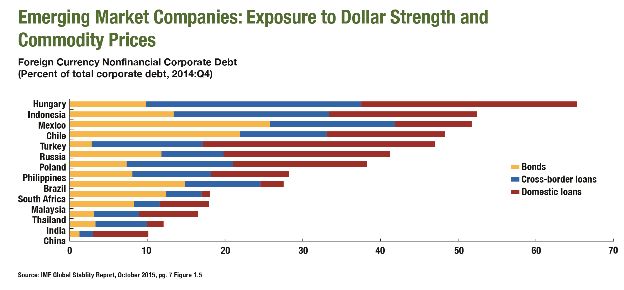With oil hitting a 12-year low below $30 per barrel and with the
volatility and decline of worldwide equities markets during the
first weeks in January 2016, some are warning of a return to the
bleak days at the beginning of the Great Recession.1 In
our April 2014 Commentary "High Yield Debt: Credit
Bubble and Litigation Risks," we warned—perhaps
presciently—that a credit bubble may be forming in the high
yield debt ("HYD") market, including in the emerging
markets ("EMs").2 In particular, soaring debt
levels in emerging markets such as China, Indonesia, Malaysia,
Thailand, Turkey, and Brazil raised concerns about the risks
associated with debt issued from emerging markets.3 Over
the past 18 months, this trend has continued,4 and
concerns about a potential bubble have intensified. The events of
the last two weeks only add further credence to existing fears that
the increasingly volatile HYD market will trigger another global
financial crisis.5
In October 2015, the International Monetary Fund ("IMF")
released a detailed report warning that as "advanced economies
normalize monetary policy, emerging markets should prepare for an
increase in corporate failures."6 In the months
following the IMF's warning, Standard & Poor's
disclosed that global corporate default rates have reached their
highest levels since 2009, with emerging market issuers
representing approximately 20 percent of defaults in
2015.7 At the same time, analysts report that over the
course of the last four years, EM default rates have risen from .7
percent to 3.8 percent, while U.S. default rates have risen from
2.1 percent to 2.5 percent over the same period.8 Some
market participants anticipate that defaults will continue to rise
in 2016.9

This Commentary highlights the legal and economic
challenges that financial institutions—particularly in their
roles as underwriters and/or placement agents for EM debt
offerings—may face in connection with emerging market debt as
significant changes in the global economy continue to develop. This
Commentary also suggests some steps a prudent institution
may now undertake to prepare and protect itself against potential
litigation that experience has shown often follows in the wake of
the market downturns.
The Macroeconomic Environment Suggests a Bumpy Road
Ahead
Over the past six to eight years, issuers in several emerging
markets have taken advantage of the global search for yield to
issue high yield bonds, often denominated in U.S. dollars or euros.
Historically low global interest rates, a strong Chinese economy,
and a strong commodity cycle all aided the rush to HYD issuers in
the emerging markets. But now, a trifecta of macroeconomic
developments portends a significant risk of corporate defaults and
perhaps broader market disruptions as the U.S. raises interest
rates, the Chinese economy falters, and the commodity cycle
turns.
Rising Interest Rates. Rising interest rates will
present substantial challenges in the high yield space as
borrowing/refinancing becomes more expensive for speculative grade
companies throughout the emerging markets. The U.S. Federal Reserve
raised rates in December 2015, and further increases are
anticipated. Normally, expectations of increased rates lead to
higher bond yields, but yields on U.S. Treasury bonds have declined
in recent months.10
A sustained increase in interest rates by the U.S. Federal Reserve
would put downward pressure on high yield bond prices and undercut
interest in this asset class.11 A possible scenario
might see investors pulling money out of emerging markets and
driving up borrowing costs for local companies.12 Higher
interest rates in the U.S. may also prompt investors to shift their
investments, in a so-called "flight to quality," that
could hobble EM issuers looking to refinance.13 Here,
any sharp uptick in capital outflows could disrupt markets as a
result of limited liquidity as investors are unable to find buyers
for the bonds that they wish to sell.14
In Southeast Asia, the effects of an increase in interest rates
could be especially acute. Foreign investors have engaged in much
of the local currency lending, but those same investors are likely
to pull their investments when interest rates rise.15
Thailand, for example, already has high rates of indebtedness, and
further rate movements by the Federal Reserve could lead to a
higher speed of outflows.16 The effects of this
potential sell-off could be compounded by the large wave of
maturities in the coming years from emerging market issuers that
took advantage of cheap borrowing.17 Recent high-profile
defaults in the HYD market, including defaults by a high-profile
Chinese real estate developer that was unable to make interest
payments on its U.S. debt in April 2015, may contribute to growing
investor concern about this market.18
The Strengthening U.S. Dollar. One immediate
impact of these developments has been the relative strengthening of
the U.S. dollar, resulting in higher debt service costs for a
number of emerging market issuers. For example, high-profile
speculative grade issuers in emerging markets such as South Africa,
Turkey, India, China, the Philippines, and Indonesia have all sold
dollar-denominated bonds in recent months.19 Over the
same period, the dollar has gained approximately 7 percent when
compared with emerging market currencies over the last 12 months,
and it has gained even more against the currencies of Brazil and
Turkey.20

In Asia, issuers have tripled their foreign-currency debt from
US$700 billion to US$2.1 trillion during the years between 2008 and
2014.21 Risks from currency fluctuations are especially
noteworthy in China, where a small group of property developers
have, since 2011, accounted for US$41 billion of total outstanding
HYD or 30 percent of all HYD in Asia.22 In fact, these
homebuilders have become the single biggest source of
dollar-denominated HYD in Asia. With maturities and defaults
looming, investors are justified in expressing concern. But these
risks are further exacerbated in countries like Turkey and South
Africa, where high external debt persists amid a dearth of U.S.
dollar-denominated cash flow.23
Issuers that sell their services and products locally and whose
revenues are in local currencies will be most exposed to exchange
rate risks as a stronger dollar leads to more expensive interest
payments on their dollar-denominated debt.24 A
significant change in currency values could lead to bankruptcies
and defaults for companies that cannot manage this increased debt
burden.25

Protective Measures: Managing Litigation
Risks
The 2008 financial crisis has taught us that once the underlying
collateral suffers distress and investors suffer losses, financial
institutions will soon be facing lawsuits engineered by
plaintiffs' attorneys to recover their clients' lost
investments through litigation: asserting claims of fraud,
negligence, incomplete/inaccurate disclosure, breach of fiduciary
duties, and breach of contract.
As noted in our April 2014 Commentary, issuers,
underwriters, dealers, and other participants in the HYD and
emerging markets should review current practices and procedures,
enhance those practices and procedures, and potentially adopt new
practices and policies to protect against the consequences of a
bursting of the HYD bubble. Now more than ever, institutions should
ensure that proper safeguards and procedures are in place to
protect against the litigation risks posed by any potential
downturns in the market.
While participants in the emerging markets cannot fully insulate
themselves from all the detrimental effects of a market failure,
institutions that move early to install appropriate safeguards to
identify, analyze, and address legal risks can minimize litigation
exposure and maximize their ability to move forward toward full
recovery and continued growth.
Four Steps You Should Consider Taking Now
- Assess Potential Exposure. Underwriters and placement agents should begin now to investigate and assess potential exposure to claims asserted by investors in debt issued by emerging market companies. In light of the relevant statutes of limitations, the inquiry should target offerings over the course of the past six years. This assessment should focus not only on onshore transactions but also on offshore transactions that may result in litigation being filed in the U.S.
- Perform Due Diligence. Comprehensive due diligence by both issuers and underwriters can minimize the likelihood that the negative consequences of changes in the macro environment will be a surprise. Understanding the details of an issuer's business model or the complexities of a structured product and how they will be affected by the many risks that are on the horizon is a crucial step in minimizing potential litigation.
- Prepare for Potential Litigation. Institutions with clients around the world have to marshal an understanding of both U.S. law and the laws of multiple jurisdictions to prepare effectively for any potential litigation, particularly in the context of bankruptcy and insolvency proceedings in a wide variety of emerging market jurisdictions. In an accompanying Commentary, we discuss some of the issues presented. The risks highlighted above will affect global markets in different ways, requiring flexible responses and an understanding of multiple legal regimes.
- Engage Counsel Early. Institutions should involve counsel during the earliest stages of any downturn in the market to analyze exposure, evaluate potential claims, and advise on sensitive internal and external communications. The speed with which modern markets move necessitates the creation of a dynamic strategy to deal with legal challenges long before they arise.
Footnotes
1 Timothy Puko and Georgi Kantchev, The Wall Street
Journal, "Oil Prices Tumble Below $30 a Barrel,"
Jan. 15, 2016.
2 Jones Day Commentary, "High Yield Debt: Credit Bubble and Litigation
Risks" at 2 (April 2014).
3 Tom Wright, The Wall Street Journal, "Mounting Debt Bridles Asia," Apr. 22,
2015.
4 See Richard Barley, The Wall Street Journal,
"Yield Hunters' New Tune Echoes Financial
Engineering's Past," Aug. 10, 2014.
5 Matt Egan, CNN Money, "Junk bonds: The next financial crisis?,"
Apr. 20, 2015; Treasury Borrowing Advisory Committee, Presentation to the Treasury: Charge 1, at 12
(released Aug. 6, 2014).
6 Global Financial Stability Report:
Vulnerabilities, Legacies, and Policy Challenges, Risks Rotating to
Emerging Markets, International Monetary Fund Report, October
2015, at 83.
7 Dan McCrumb, Financial Times, "Global defaults climb to 6-year peak of
$95bn," Nov. 30, 2015.
8 Anjani Trivedi, The Wall Street Journal, "Emerging-Market Defaults Rise After Asia's
Debt Pileup," Nov. 30, 2015.
9 Dan McCrumb, Financial Times, "Global defaults climb to 6-year peak of
$95bn," Nov. 30, 2015.
10 Matt Wirz, The Wall Street Journal, "Junk Bonds Find Buyers After Crude's Trip
Down," Mar. 31, 2015.
11 Vivianne Rodrigues, Financial Times, "High-Yield Debt Market Defies Sceptics,"
Mar. 18, 2015.
12 Tom Wright, The Wall Street Journal, "Mounting Debt Bridles Asia," Apr. 22,
2015.
13 Fiona Law, The Wall Street Journal, "Jitters Stifle Asia's Junk-Bond
Market," Jan. 15, 2015.
14 Katy Burne, The Wall Street Journal, "Junk-Debt Liquidity Concerns Bring
Sales," Aug. 3, 2014.
15 Tom Wright, The Wall Street Journal, "Debt Piles Up in Asia, Threatening
Growth," Apr. 21, 2015.
16 James Kynge, Financial Times, "Thailand's credit binge: now for the
hangover," Apr. 20, 2015.
17 Chien Mi Wong, FinanceAsia, "Asia High-Yield to Plough Through Head
Winds," Dec. 10, 2014.
18 Chris Bourke, Vinicy Chan, and Cordell Eddings,
BloombergBusiness, "Major Chinese Developer Says It Can't Pay
Dollar Debts," Apr. 20, 2015.
19 Fiona Law, The Wall Street Journal, "Jitters Stifle Asia's Junk-Bond
Market," Jan. 15, 2015; Chien Mi Wong,
FinanceAsia, "Asian Bond Rush Ahead of Lunar Holidays,"
Feb. 1, 2015.
20 Ian Talley and Anjani Trivedi, The Wall Street Journal,
"Dollar's Surge Pummels Companies in Emerging
Markets," Dec. 30, 2014.
21 The Economist, "Feeling Green," Mar. 21,
2015.
22 Christopher Langner and Lianting Tu, BloombergBusiness,
"We're Just Learning the True Cost of
China's Debt," Apr. 22, 2015.
23 The Economist, "Feeling Green," Mar. 21,
2015.
24 Ye Xie, BloombergBusiness, "As Emerging-Market Debt Crisis Talk Grows, Some
Investors Scoff," Apr. 1, 2015.
25 Neil Irwin, The New York Times, "How a Rising Dollar Is Creating Trouble for
Emerging Economies," Mar. 16, 2015.
The content of this article is intended to provide a general guide to the subject matter. Specialist advice should be sought about your specific circumstances.



